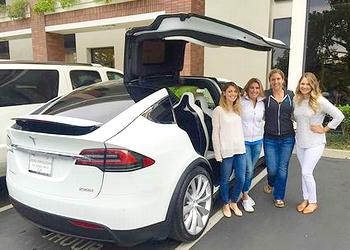
By Jon LeSage
NEW YORK, New York, May 3, 2017 (ENS) – Speaking at the Bloomberg New Energy Finance conference in New York last week, Total SA’s chief energy economist Joel Couse predicted that electric vehicles will make up 15 to 30 percent of global new vehicle sales by 2030.
Oil demand for transportation fuel will see its “demand will flatten out,” after 2030, Couse said. “Maybe even decline.”
Colin McKerracher, head of advanced transport analysis at Bloomberg New Energy Finance, BNEF, sees Couse’s forecast as the highest EV sales margin yet to be forecasted by a major company in the oil sector.

“That’s big,” McKerracher said. “That’s by far the most aggressive we’ve seen by any of the majors.”
Royal Dutch Shell Plc sees a similar trend with oil demand in transportation flattening out in the near future. Chief Executive Officer Ben van Beurden said in March that oil demand may peak in the late 2020s. In November during an interview, Shell Chief Financial Officer Simon Henry said that demand is expected to peak in about five years.
Shell and Total SA have been looking to diversify their energy assets through hydrogen as a transport fuel. In January, both companies joined a global hydrogen council that includes Toyota, Liquide SA, and Linde AG. The companies will be investing about US$10.7 billion in hydrogen products over the next five years.
Like hydrogen fuel cell vehicles, electric vehicles have major walls to climb to find mass adoption in vehicle sales and infrastructure.
One barrier is the cost of owning an electric vehicle versus a cheaper, comparable gasoline-engine vehicle. The battery pack in an EV can be quite expensive, making up half the cost of the car, according to BNEF.
Backers of EVs point to two trends fast approaching the market. One is the longer range, 200-plus-miles per charge EVs coming to market like the Chevy Bolt and Tesla Model 3, both for sale at US$36,000 or less.
The higher-priced versions of the Tesla, both Model S and Model X, are thought to be a sign of EV desireability, with consumers willing to finance or lease one of these EVs to gain access to more power and longer range.
Automakers are feeling pressed by strict emissions reduction rules in Europe and China, with other markets like the United States, Japan, and South Korea having similar standards.
In China, Auto Shanghai, held April 21-28, has been a showcase for existing and startup automakers debuting at least seven electric cars to the China market.
It’s helping that lithium ion battery prices are dropping about 20 percent per year, as automakers spend billions on electrifying their vehicle lineups.
Volkswagen wants to see at least 25 percent of its vehicles sold in 2025 to be electric. Toyota is moving toward selling zero fossil-fuel powered vehicles by 2050.
Another sign that the Total SA report carries some weight is the diverse and broad portfolio of EVs that automakers till be rolling out on the market soon.
“By 2020 there will be over 120 different models of EV across the spectrum,” said Michael Liebreich, founder of Bloomberg New Energy Finance. “These are great cars. They will make the internal combustion equivalents look old fashioned.”
Today, electric cars make up about one percent of global vehicle sales, so making it to 30 percent in the short-term future would be a huge leap.
Analysts point to a few market forces that need to be addressed before that technology takes off in sales. Among those issues are pre-incentive prices coming down, distance per charge going up beyond 300 miles, and the fast charging infrastructure becoming pervasive and cost competitive with gas pumps.
{Republished with permission from Oilprice.com.}
Copyright Environment News Service (ENS) 2017. All rights reserved.
